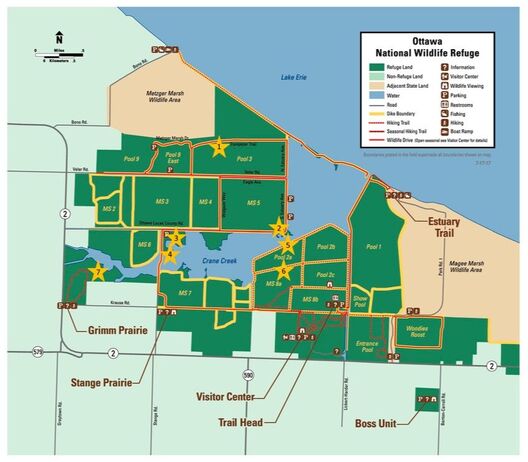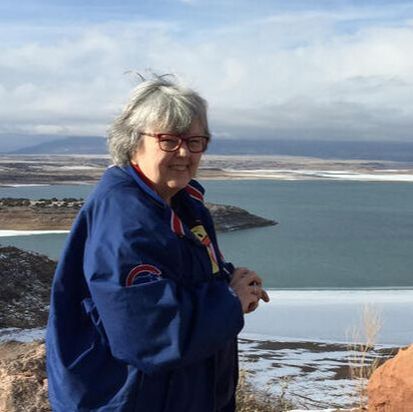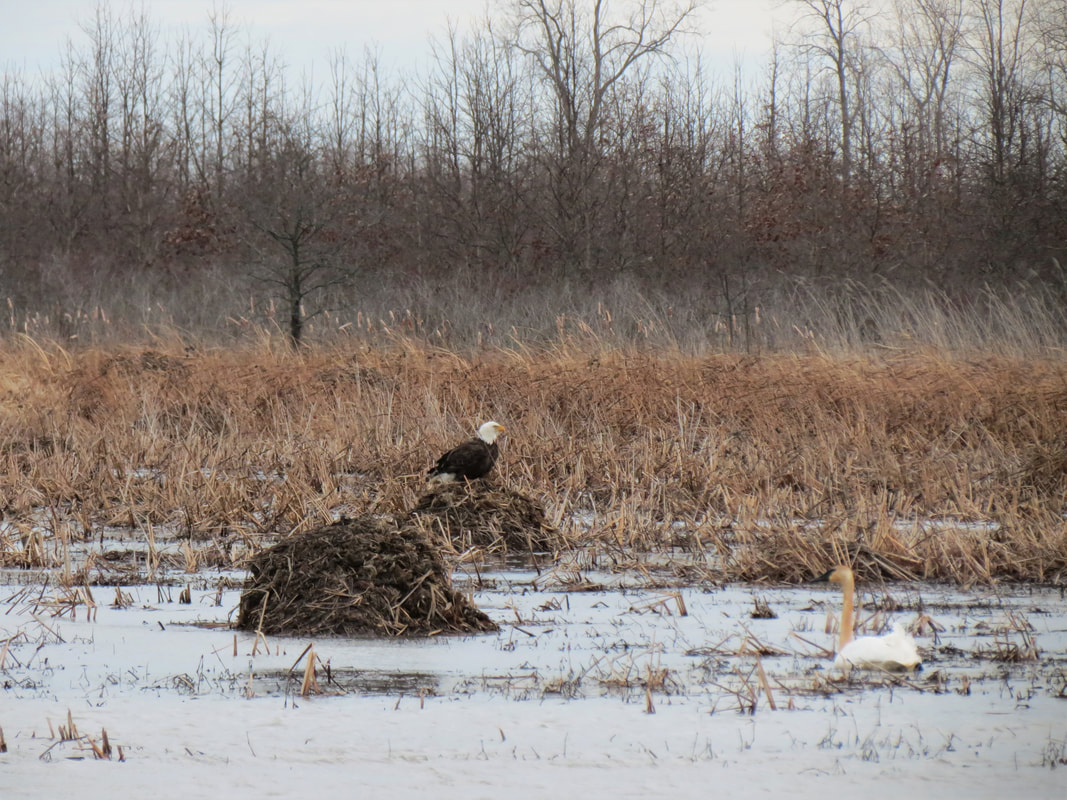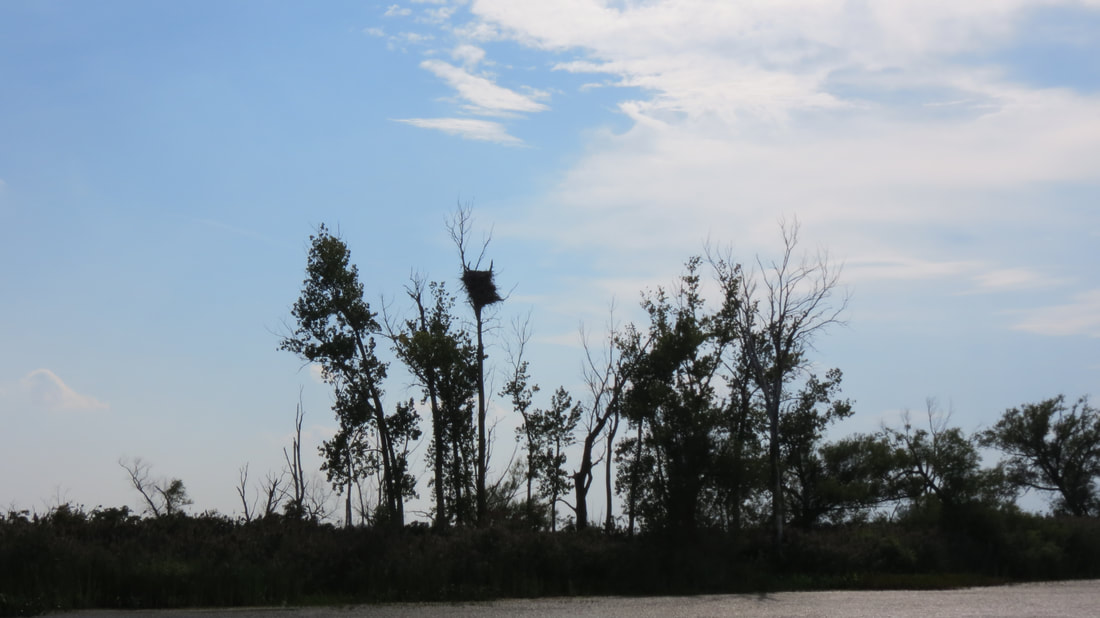Bald Eagle Nest Updates
Ottawa National Wildlife Refuge is home to one of the densest populations of bald eagles next to Alaska! Allow this page to be your go-to resource for the most up to date information about the refuge's bald eagles.
|
August 11, 2021 Thunderstorm
Early in the morning on August 11, 2021 a series of severe thunderstorms battered the refuge. The main refuge complex lost 6 out of 8 eagle nests. The size of bald eagle nests varies considerably because bald eagles reuse their nest. Every year bald eagles add new material which adds one to two feet of height. Some of the older nests can weigh as much as a car! That weight with high winds is a recipe for disaster. If it had to happen, August is probably the best possible time from the perspective of our eagles. The eaglets fledge in July and the adults will have plenty of time to spend their fall finding suitable new nest sites and starting over. Now we need your help! Please help us keep an eye on our bald eagles. If you notice any nesting activity on Ottawa National Wildlife Refuge, please fill out this datasheet. We will share this information with our refuge biology staff who will continue to protect Ottawa Refuge's bald eagle population. |
Restoring Habitats for Eagles and Wildlife
Bald eagles love to nest in tall trees near water, so Ottawa National Wildlife Refuge is perfect for them. The conservation of our wetland habitats is critical to their survival. If you'd like to make an impact on the refuge and our eagles, consider making a donation or Adopt an Eagle today. Nests and Names
If you've attended a Refuge Eagle Tour, you may have heard your guide call the nests (and maybe even the birds!) by name. The map below will serve as a guide to show you where these nests are located on the main complex. The blue stars on the map are neighboring nests that are not on refuge property, just for your information. Two of these are located at Magee Marsh Wildlife Area which is open to the public. Current Eagle Nest Locations (2022)After the August 2021 storms, two eagle nests remain intact on the main complex. These include the Pool 3 nest and one near the Crane Creek bridge on the Refuge Wildlife Drive. The nest visible from Woodies Roost is also intact.
|
|
Fast Facts
Your Virtual Guide
Becky Traxler got into birding after joining Ottawa National Wildlife Refuge volunteer Tom Furry on an Eagle Tour. After that spark, she started volunteering herself at Ottawa National Wildlife Refuge. Since 2014, she has served dual volunteer roles with the U.S. Fish and Wildlife Service and the Friends group.Becky has been very willing to take on any job we throw her way. She helps out at special events and leads some of Ottawa’s bus tours during the Biggest Week. She also works the front desk at the Visitor Center on Sundays and Tuesdays and enjoys shopping for new merchandise for the Rookery Nature Store. She loves to direct visitors towards finding their target bird species. Becky takes great pride in introducing new people to the refuge (and in keeping Ottawa’s staff well fed with yummy treats!) As if all of that were not enough, she has even started leading the Eagle Tours where her interest was first sparked. A big part of leading Eagle Tours involves knowledge of these raptors, so in her free time Becky keeps tabs on all of the eagles. She watches their nests, tracking where old ones fall and new ones are built as well as how many chicks hatch from each in the spring time. Her work as a nest monitor helps keep the refuge biology team up to date on Ottawa’s 18+ pairs of eagles. |
All About Eagles"Although they primarily eat fish and carrion, bald eagles used to be considered marauders that preyed on chickens, lambs, and domestic livestock. Consequently, the large raptors were shot in an effort to eliminate a perceived threat. Coupled with the loss of nesting habitat, bald eagle populations declined. In 1940, noting that the species was “threatened with extinction,” Congress passed the Bald Eagle Protection Act, which prohibited killing, selling, or possessing the species. A 1962 amendment added the golden eagle, and the law became the Bald and Golden Eagle Protection Act.
Shortly after World War II, DDT was hailed as a new pesticide to control mosquitoes and other insects. However, DDT and its residues washed into nearby waterways, where aquatic plants and fish absorbed it. Bald eagles, in turn, were poisoned with DDT when they ate the contaminated fish. The chemical interfered with the ability of the birds to produce strong eggshells. As a result, their eggs had shells so thin that they often broke during incubation or otherwise failed to hatch. DDT also affected other species such as peregrine falcons and brown pelicans. In addition to the adverse effects of DDT, some bald eagles have died from lead poisoning after feeding on waterfowl containing lead shot, either as a result of hunting or from inadvertent ingestion. By 1963, with only 417 nesting pairs of bald eagles remaining, the species was in danger of extinction. Loss of Dave Menke, USFWS habitat, shooting, and DDT poisoning contributed to the near demise of our national symbol." |












